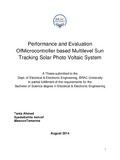| dc.contributor.advisor | Rahman, Dr. Md. Mosaddequr | |
| dc.contributor.author | Ahmed, Tania | |
| dc.contributor.author | Ashraf, Syeda Eshita | |
| dc.contributor.author | Tamanna, Masrura | |
| dc.date.accessioned | 2014-09-10T09:17:27Z | |
| dc.date.available | 2014-09-10T09:17:27Z | |
| dc.date.copyright | 2014 | |
| dc.date.issued | 2014-08 | |
| dc.identifier.other | ID 10221058 | |
| dc.identifier.other | ID 10121057 | |
| dc.identifier.other | ID 10221019 | |
| dc.identifier.uri | http://hdl.handle.net/10361/3591 | |
| dc.description | This thesis report submitted in partial fulfillment of the requirement for the degree of Bachelor of Science in Electrical and Electronic Engineering, 2014. | en_US |
| dc.description | Cataloged from PDF version of thesis report. | |
| dc.description | Includes bibliographical references (pages 55-56). | |
| dc.description.abstract | Solar energy systems have emerged as a viable source of renewable energy over the past two or three decades, and are now widely used for a variety of industrial and domestic applications. Such systems are based on a solar collector, designed to collect the sun’s energy and to convert it into either electrical power or thermal energy. Solar energy is predictable to play a great role in the infrastructure as a distributed source, due to the fact that it is an easily available renewable source of energy. In a country like Bangladesh where electricity generation has become an immense job since it has been suffering from a huge crisis despite of the fact that several natural grid has been added to the national power grid but still it is not enough. The country lags behind than its expected production capacity. The main focus of the project is to design and implement a system sufficient enough to generate electricity, take less space and will be highly efficient for urban areas in Bangladesh. Solar tracking system is the most appropriate technology to enhance the efficiency of the solar cells by tracking the sun. A microcontroller based design methodology of an automatic solar tracker is presented in this paper. The proposed system comprises of three panels stacked one upon another at a fixed distance from each other so that the overall system ends up with a minimum space which is suitable for urban areas that has very low floor space. The panels are supported by a metal rod fixed at tilt angle equal to the latitude among north-south direction facing south. (23°) The panels rotate throughout the day from sunrise to sunset via motors equipped with them controlled by microcontroller which enables rotation of the three panels at hourly intervals on a fixed horizontal axis to track the sun and maximize power generation. The system escorted by an actuator that changes the entire position of the three panels after midday when the sun moves toward west. The anticipated system will provide a useful solution to electricity problems in urban areas where space is limited. | en_US |
| dc.description.statementofresponsibility | Tania Ahmed,
Syeda Eshita Ashraf,
Masrura Tamanna | |
| dc.format.extent | 55 pages | |
| dc.language.iso | en | en_US |
| dc.publisher | BRAC University | en_US |
| dc.rights | BRAC University Internship reports are protected by copyright.
They may be viewed from this source for any purpose,
but reproduction or distribution in any format is prohibited
without written permission. | |
| dc.subject | Electrical and electronic engineering | en_US |
| dc.subject | Solar tracking system | en_US |
| dc.subject | Solar energy | en_US |
| dc.title | Performance and evaluation of microcontroller based multilevel sun tracking solar photo voltaic system | en_US |
| dc.type | Thesis | en_US |
| dc.contributor.department | Department of Electrical and Electronic Engineering, BRAC University | |
| dc.description.degree | B. Electrical and Electronic Engineering | |

